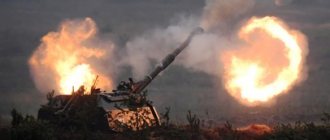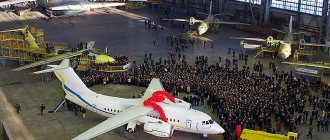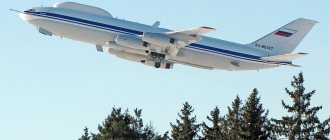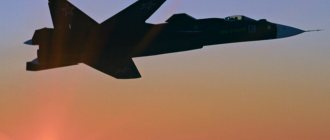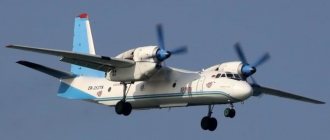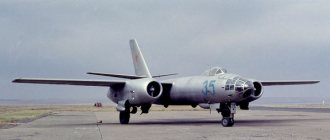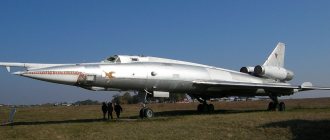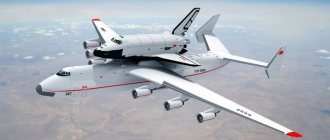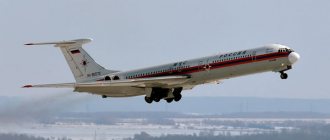| TB-3 (ANT-6) | |
| TB-3. | |
| Type | heavy bomber |
| Developer | AGOS TsAGI |
| Manufacturer | Plants of the Ministry of Aviation Administration of the USSR: No. 18 (Voronezh) No. 22 (Moscow) No. 39 (Moscow) |
| Chief designer | Tupolev A. N. |
| First flight | December 22, 1930 |
| Start of operation | 1932 |
| End of operation | January 1946 |
| Status | decommissioned |
| Main operators | Red Army Air Force |
| Years of production | 1932 — 1938 |
| Units produced | 818 |
| Images on Wikimedia Commons | |
TB-3TB-3
Tupolev TB-3
(also known as
ANT-6
) is a Soviet heavy bomber that was in service with the USSR Air Force in the 1930s and during the Great Patriotic War.
Despite the aircraft's obsolescence, and the fact that it was officially withdrawn from bomber (but not military transport) service in 1939, the TB-3 was used as a heavy bomber and transport aircraft for most of World War II. A total of 818 examples were built. Not a single copy of TB 3 has survived to this day.
History of creation
In 1925, the command of the USSR Air Force turned to TsAGI with the requirement to develop a heavy bomber with an engine power of 2000 hp. With. and with a wheeled or ski chassis.
The Tupolev Design Bureau begins work on the project in 1926, although the final requirements of the state become known only in 1929. Curtiss V-1570 engines
) “Conqueror” (590 hp each), during production it was planned to replace them with Mikulin M-17 (modified BMW VI). An experimental model with a ski chassis was tested on December 22, 1930 by Mikhail Gromov. On February 20, 1931, the USSR Air Force launched the ANT-6 with M-17 engines into mass production.
The prototype was re-equipped with engines developed by TsAGI, BMW VI 500 (720 hp each), with larger radiators and a constant angle of attack of wooden blades. Single-wheel chassis were considered too fragile and were replaced by trolley chassis with 1350x300 mm wheels. The first modification, before launch into mass production called TB-3-4M-17
, took off on January 4, 1932 (under the control of A. B. Yumashev and I. F. Petrov). Unexpectedly, it turned out that the aircraft that had already entered mass production was 10-12% heavier than the prototype, which significantly affected the technical characteristics. The poor quality of the raw materials was reflected in the sheet metal used in the aircraft's skin, tubes, wires - all of which turned out to be thicker than in the carefully assembled prototype. The thick layer of paint used for the camouflage coating also affected the mass. Factories invited their workers to make suggestions regarding weight reduction, paying 100 rubles for each kilogram of weight removed. Together with the OKB's attempts, the weight of the aircraft was reduced by almost 800 kg. Thus, the aircraft produced could differ from each other in weight up to several hundred kilograms.
In 1933, the streamlining of one TB-3-4M-17F was improved - the turrets and bomb mounts were removed, all holes were patched and the landing gear fairings were adjusted. All this only led to an increase in maximum speed by 4.5% and approximately the same increase in flight radius. Tupolev concluded that increasing the streamlining of large and slow aircraft does not bring much benefit. Further work in this area in January-February 1935 led to the fact that the maximum speed was increased by 5.5% and the service ceiling was increased by 27.5%. The same aircraft, equipped with four experimental single-blade propellers, showed a significant increase in climb speed.
Record flights:
- TB-3-4M-34R was in the air for 18 hours and 30 minutes.
- TB-3-4AM-34FRN piloted by A. B. Yumashev set several payload-altitude records: September 11, 1936 - 5,000 kg at an altitude of 8,116 m, improved to 8,980 m on October 28.
- September 16, 1936 - 10,000 kg at an altitude of 6605 m.
- September 20, 1936 - 12,000 kg at an altitude of 2700 m.
Combat use of TB-3 heavy bombers
Mass deliveries of TB-3, which began already in 1932, allowed the USSR by the mid-30s. to create the most powerful strategic aviation, consisting of heavy bomber brigades, which since 1936 have been consolidated into 3 special-purpose armies. In addition to bombing missions, TB-3s were widely used to provide combat training for airborne troops, acting as transport aircraft. By January 1, 1938, the Red Army Air Force had 626 serviceable TB-3s.
On August 6, Japanese positions near the Zaozernaya hill were bombed by 41 TB-ZRN, which used, along with smaller ammunition, 1000-kg bombs. In 1939, TB-3 (including old machines with M-17) were used at Khalkhin Gol, where 23 of these aircraft were concentrated. Initially, they were used exclusively as transport ones, and from August 19 they began to be used for night harassing raids.
TB-3s of the 7th TBAP, as well as a number of squadrons allocated from other regiments, took part in the “winter war” with Finland. Initially, they operated during the day, with single aircraft or small groups, striking targets with weak air defense. From January 1940, more and more raids were carried out at night, and from March 10, a ban on TB-3 combat sorties during the day was introduced. At the final stage of the conflict, TB-3 bombed the fortifications of the Mannerheim Line. But the bulk of the 7043 sorties performed by these aircraft during the war with Finland were transport operations. Combat losses amounted to 5 aircraft, another 8 aircraft were written off for non-combat reasons.
By February 1, 1940, the Air Force had 509 TB-3s (409 serviceable). By that time, the obsolescence of the low-speed bomb carrier was obvious, and even a decision was being prepared to remove it from service. But due to delays in the release of new DB-ZF and DB-240 aircraft, the old aircraft continued to be used. Moreover, due to repairs, the number of TB-3s even increased slightly: on June 22, 1941, the Red Army Air Force had 516 TB-3s, and another 25 were in naval aviation. 6 heavy bomber regiments flew such aircraft.
The first combat missions in the Great Patriotic War were carried out on the night of June 23 by TB-3s from the 3rd TBAP, striking enemy troop concentrations. The next night, vehicles of the 1st and 3rd TBAP bombed several German airfields. Similar operations continued in the following weeks. TB-3s were also involved in daytime raids, which almost always led to significant losses among the bombers.
The presence of a significant number of TB-3s in rear districts and educational institutions made it relatively easy to compensate for the losses of the first weeks of the war. If on July 22, 1941, 51 aircraft of this type were operating on the Soviet-German front, then a month later this number increased to 127. The removal of aircraft from the rear and schools even made it possible to create new units - for example, at the end of the summer of 1941 on the TB- 3 the 325th TBAP was formed. In the most difficult months of the war, old bombers played a very noticeable role in the main directions - for example, in the Air Force of the Western Front, which was holding back the onslaught on Moscow, on September 25, 1941, there were 25 TB-3s - about 40% of the bombers available there. On the night of October 9-10, planes of the 1st and 3rd TBAP bombed a concentration of enemy troops south of Yukhnov, the next night near Vyazma, then worked on airfields in Borovsky, Shatalovo, and Orsha.
In 1942, TB-3s increasingly focused on transport missions. However, occasionally they were used for bombing strikes. So, in July they took part in raids on the railway junction in Bryansk. At the same time, one 2000-kg bomb was dropped - the heaviest ammunition used with the TB-3. Aircraft from the 53rd and 62nd ADD took part in the Battle of Stalingrad, bombing crossings across the Don at night. By the end of 1943, they finally switched to the role of transport workers, but even as of May 10, 1945, there were 39 TB-3s in the 18th VA (former Long-Range Aviation)! These vehicles were finally withdrawn from service only at the beginning of 1946. In October 1937, 6 TB-3RNs were transferred to China, where they were used exclusively as transport vehicles.
The TB-3 aircraft became a kind of “super-conscript” - although by the beginning of the Great Patriotic War it was already hopelessly outdated, nevertheless, units armed with these aircraft actively participated in night bombing raids until 1943. TB-3 also played an extremely important role in transport operations.
Design
TB-3 was an all-metal duralumin aircraft. The aircraft frame was composed of V-shaped beams covered with stable corrugated skin with a thickness of 0.3 to 0.8 mm. The differences in the corrugated shell were 13 mm, and in some places 50 mm. The cantilever wing was supported by four beams. In 1934, thanks to research into steel alloys, the wing span was increased from 39.5 to 41.85 m. It became possible to walk on the plane in soft shoes without damaging the skin. The wing was mechanized using a cable system. In case of failure of one of the engines, the aircraft was equipped with a balancing system. The non-retractable main landing gear was not equipped with brakes. The fuel tanks had no protection against leaks or fire. The M-17 engines were designed for a maximum possible flight range of 3,250 km without replacing spark plugs or clogging the carburetor. The aircraft's defense consisted of light machine guns in five turrets - one on the nose, two on top in the middle of the fuselage, and one retractable under each wing. In subsequent modifications, one upper turret was moved closer to the tail fin.
History of application
Although the TB-3 was obsolete by the mid-30s, it was actively used during local armed conflicts in the second half of the 1930s.
Around 1938, a daytime flight over the Japanese islands was carried out, during which propaganda leaflets were scattered [ clarify
].
During the fighting near Lake Khasan in the summer of 1938, 41 TB-3RN bombers took part in the bombing of the Zaozernaya and Bezymyannaya heights on August 6, 1938[1].
During the battles at Khalkhin Gol in the summer of 1939, the TB-3 was used as a night bomber (more than 500 sorties were carried out in total), as well as as a military transport aircraft[2].
The aircraft was officially withdrawn from service only in 1939, but was also used during the Soviet-Finnish war of 1939-1940.
By the beginning of the Great Patriotic War on June 22, 1941, the USSR Air Force had 516 ready-made aircraft, not counting the 25 that were subordinate to the USSR Navy. On June 23, TB-3 began night bombing of enemy territory. It should be noted that TB-3 aircraft were not actually damaged in the first days of the war, since they were based quite far from the borders (by August 1941, TB-3 accounted for 25% of all bombing air forces), and in general, losses were relatively small - for 1941 a year, for all reasons, including non-combat losses and those abandoned during the retreat, less than 40 aircraft were lost. Forced attempts to use the TB-3 during the day completely failed: despite the very high survivability, the low speed made the aircraft vulnerable to anti-aircraft guns, and the all-round, but frankly weak, defensive weapons left it virtually defenseless against modern fighters. The tragic episode with the destruction of the TB-3 group, which flew out during the day and without cover, was described by Konstantin Simonov in the first part of the trilogy novel “The Living and the Dead”, and was also embodied in the film adaptation of the novel. However, as a night bomber, the TB-3 turned out to be a very successful option, since its low speed contributed to the accuracy of its bombing. It is important that initially the most experienced pilots were selected for the TB-3 crews, and in good weather one crew could make up to three combat sorties during the night. Taking into account the total number of aircraft involved, this made a significant contribution to night bombing in the first half of the war. TB-3 took part in all important battles of 1941-1943, including the Battle of Smolensk, the Battle of Moscow, the Battle of Stalingrad, breaking the siege of Leningrad and the Battle of Kursk. By July 1, 1945, the 18th Air Division still had ten TB-3 aircraft in combat readiness.
For a long time, the TB-3 was used as a cargo and landing aircraft, capable of carrying up to 35 soldiers. In the first five months of the war, TB-3 aircraft transported 2,797 tons of cargo and 2,300 people.
The TB-3 was also used to transport tankettes such as the T-27, T-37 and T-38 and as a fighter carrier. On July 26 (according to other sources - August 1), 1941, two TB-3s - carrying four I-16 fighters (Vakhmistrov's Link) bombed the oil refinery and the dock of Constanta without losses [3]. On August 11 and August 13, 1941, during two raids (the first - jointly with DB-3F and Pe-2), I-16 250-kg fighters launched from TB-3 first damaged and then destroyed the strategically important Chernavodsky bridge across the Danube in Romania, at the same time the oil pipeline was set on fire. Later, Zven aircraft attacked the crossing of the Dnieper and German columns in the battles at Perekop. Bombing in the group stopped in the fall of 1941 due to the high wear and tear of the engines of the Zvena bombers and the gradual increase in the number of Pe-2s. The remaining TB-3s of the same modification, the production of which was discontinued back in 1937, were considered appropriate to be used as transport ones.
There were unsuccessful attempts to use radio-controlled TB-3 as projectile aircraft.
On June 18, 1945, three TB-3 aircraft were included in the air column of the Victory Parade due to their important role in the war (the column's flyover was canceled due to heavy rain and low clouds).
All the drama of the combat use of low-speed TB-3 bombers in the first months of the Great Patriotic War is reflected in the episode of the fiction novel: “The Living and the Dead” (part 1)[4].
Introduction
The Tupolev TB-3
(also known as
the ANT-6
) was a heavy bomber used by the Soviet Air Force in the 1930s and during World War II.
In the USSR it was often called the world's first four-engine all-metal aircraft with a cantilever wing, although this is not at all true. For example, the giant four-engine passenger airliner Junkers G.38 took off a year earlier (first flight of TB-3 on 12/22/1930, first flight of G.38 on 11/06/1929).
Despite the aircraft's obsolescence, and the fact that it was officially withdrawn from bomber (but not military transport) service in 1939, the TB-3 was used as a heavy bomber and transport aircraft for most of World War II. Also used to move light tanks. A total of 818 examples were built.
Modifications
TB-3-4M-17F The first production modification, accounting for approximately half of all TB-3s built. TB-3-4M-34 Modification with AM-34 engine (improved radiators, added oil cooling), produced in a small series TB-3-4M-34R Modification with AM-34R engines with gearbox. Reducing the speed of the propeller made it possible to increase its efficiency, which improved the flight characteristics of the aircraft. TB-3-4AM-34RD A range of long-range aircraft with improved fuselage streamlining and wheel brakes. Some aircraft had one main landing gear with a wheel diameter of 2 m and metal three-bladed propellers. Used for flights to Warsaw, Paris and Rome in 1933-1934. TB-3-4AM-34RN High-altitude modification with AM-34RN engines, four-bladed propellers of internal engines and two-bladed external ones, one two-meter main landing gear, updated ShKAS machine guns in turrets, maximum speed increased to 288 km/h at an altitude of 4200 m, service ceiling - 7740 m. Tested in August-October 1935, but never entered into mass production. TB-3-4AM-34FRN/FRNV Engines AM-34FRN/FRNV with increased power and four-blade propellers, improved aerodynamics, chassis with brakes, maximum speed of more than 300 km/h. TB-3D Test modification with an AN-1 diesel engine (740 hp) and an estimated flight radius of 4,280 km. Did not enter mass production, since other characteristics were worse than those of the TB-3-4AM-34RN G-2 Transport modification of the TB-3 with the M-17 and M-34 engines, converted to meet the needs of Aeroflot. During the war years, sulfur was exported from Central Asian deposits, and drinking water was delivered to the miners on return flights. ANT-6-4M-34R “Aviaarktika” Five TB-3 for the expedition to the North Pole in 1937 with a closed cockpit and metal three-bladed propellers.
Military historians intend to restore the TB-3 aircraft that crashed in the Arctic in 1942.
St. Petersburg, June 22, 2017. Researchers expect that they will be able to bring the aircraft to good display condition, and maybe even lift it into the air.
Heavy bomber TB-3 with M-17F engines. Photo / aviaru.rf
Researchers from the Military Historical Center of the Northwestern Federal District found in the Timan tundra (Nenets Autonomous District) and delivered to a storage facility near St. Petersburg a heavy bomber TB-3 that crashed in 1942. To begin work on its restoration, they are looking for a convenient place. Researcher Pavel Filin told TASS about this. “We want to create a small museum in the hangar, where we will carry out work on restoring the aircraft. Visitors will be able to observe this process,” he said, adding that the group is now looking for a suitable area where they could build a hangar and begin restoration work.
TB-3 in the Timan tundra. Photo / Military History Center of the Northwestern Federal District.
His colleague Margarita Emelina spoke about attempts to restore the history of this aircraft from the archives. “At the moment it is known that the plane died in April 1942. There was no information about him in the Gatchina Military Archives and the Archives of the Naval Department. We are checking the version that it belongs to ground units,” she said.
There are no more surviving aircraft of this type. This is what prompted historians of the Military Historical Center to begin a project to restore TB-3. A small mock-up of such an aircraft can be seen in the Museum of the Arctic and Antarctic, since aircraft of this type have been adapted for work in the Arctic since 1936, when Soviet Arctic aviation made a name for itself with transpolar flights and spectacular rescue operations.
“This plane was assembled in 1933, it was found in the Arctic zone, so we see it as an interesting exhibit that reveals the history of Arctic aviation,” believes Filin.
Restoring the aircraft, according to Pavel Filin, will take 3-4 years. Its hull and wings are well preserved, but there are no engines. When restored, the researchers expect to be able to bring it to good display condition, and maybe even lift it into the air.
The plane was found in a remote area of the Timan tundra. Researchers suggest that it could transport people (capacity up to 10 seats), documents, supplies from Naryan-Mar airport to Yagodnik airport or in the opposite direction. “We did not find any signs of participation in the battle with the Germans, and the location of the plane slightly to the side of the transport corridor may indicate bad weather as the cause of the accident,” noted Margarita Emelina.
According to the agency's interlocutor, local reindeer herders knew about the plane from the moment it crashed. Gradually, the information became available to local historians, and from them to researchers from St. Petersburg. Researchers managed to visit the scene of the accident in 2008, but they were able to transport the plane to a warehouse near St. Petersburg only this spring.
Local historians recorded and passed on to historians the stories of eyewitnesses that they saw six members of the TB-3 crew in the hospital, however, according to Margarita Emelina, this version requires re-checking, since another similar plane was found near the scene of the accident, but in much worse condition preservation, not suitable for reconstruction.
By | June 22nd, 2017|News|
Performance characteristics
The characteristics below correspond to the TB-3
(1933):
Data source:
Gordon, Khazanov, 1999;
Shavrov, 1985; Kotelnikov, 2008. Technical characteristics
- Crew:
6-8 people - Length:
24.4 m - Wingspan:
39.5 m - Height:
- Wing area:
230.0 m² - Empty weight:
10,967 kg - Normal take-off weight:
17,200 kg - Maximum take-off weight:
19,500 kg - Fuel tank capacity:
7,960 l - Powerplant:
4 × piston M-17F - Engine power:
4 × 715 hp (4 × 533 kW (takeoff)) - Propeller:
two-blade, wooden TsAGI - Screw diameter:
3.5m
Flight characteristics
- Maximum speed: at altitude:
177 km/h at 3,000 m - at the ground:
197 km/h
1,350 km
3,120 km (at maximum take-off weight)
3,800 m
- 1,000 m in 9.2 minutes
74.8 kg/m²
85.5 W/kg (8.6 kg/hp)
170-200 m
300 m
Armament
- Small arms:
4-8 × 7.62 mm machine guns - Combat load: normal:
2,000 kg - maximum:
5,000 kg
- in bomb bay:
28 × 50 kg
or
82 kg
or
100 kg bombs
4 × 250 kg
or
500 kg
or
1000 kg bombs
Bomber TB-3 (ANT-6) – video
https://youtube.com/watch?v=9LxPMTU9IB8
In the middle part there were two more shooters, one on each side. The power plant consisted of four American Conqueror engines of 600 hp each. . The first prototype of the TB-3 was built in the fall of 1930. The aircraft made its first flight on December 22, 1930 under the guidance of TsAGI test pilot M.M. Gromov from the central airfield named after. Frunze. The tests lasted until February 20, 1931. At a meeting of TsAGI representatives, it was noted that the bomber was quite modern in its flight characteristics. At the same time, they pointed out the shortcomings of the firing points, which limited the sphere of fire to the rear, excessive loads on the rudders, the low efficiency of the tail unit and the lack of communication between crew members. Then M-17 engines (BMW VI) with wooden propellers were installed on the prototype aircraft. After completing the full test cycle, the aircraft was put into production.
The first production aircraft TB-3 (ANT-6) made its first flight on February 27, 1932. A total of 819 aircraft of several variants were built by three factories before 1938. A year later, the Air Force Research Institute made an attempt to improve the aircraft's flight characteristics. The modified aircraft in August 1933 made a non-stop flight along the route Shchelkovo - Evpatoria - Shchelkovo in 15.5 hours. 2,500 kg of bombs were dropped at the site in Yevpatoria. In 1933, M-34 engines began to be installed on production aircraft, and with them the aircraft's performance characteristics improved somewhat.
TB-3 aircraft were used in various flight experiments. At the suggestion of P.I. Grokhovsky developed mounting points for the suspension of military equipment under the fuselage of the TB-3. They were able to transport cars, guns, motorcycles and even T-37 light tanks. In 1933, experiments were carried out on in-flight refueling from the R-5 and TB-3. A device was tested for transferring fuel from a flying tanker to a bomber. On the basis of TB-3, tests were carried out under Vakhmistrov’s “Link” program. Since 1934, the bomber was used as an aircraft. Various options were installed and attached to the TB-3: three I-5s, two I-Zs or two I-16s, two I-16s + two I-5s + I-Zs.
The TB-3 (ANT-6) made several long-distance flights, including a flight to the capitals of European countries. In 1936, the aircraft set six world records for loaded flight altitude. On four ANT-6A Aviaarktika, a scientific expedition landed at the North Pole and the drifting station SP-1 was created. On the N-170 plane M.V. Vodopyanov landed on an ice floe 20 km from the North Pole.
TB-3 aircraft became the basis for the formation of the first strategic aviation formations in the USSR and in the world. They were used in all military conflicts (except Spain) in which the USSR participated in the 1930s. They fought in Manchuria, on Lake Khasan, on the Khalkhin Gol River and in the war with Finland. In the first months of the war with Germany, TB-3 aircraft were used as day bombers, which led to heavy losses. Subsequently, the aircraft were used only in night bombing missions. They were used both as transport and landing vehicles.
Notes
- TB-3 // A. I. Kharuk. Strike aircraft of the Second World War - attack aircraft, bombers, torpedo bombers. M., “Yauza” - EKSMO, 2012. p.205-208
- Soviet-Japanese wars 1937-1945. - M., 2009. - P. 165.
- "I-16" and "TB-3" were used to strike ships and ground targets in Romania. The fighters were transported by TB-3 bombers. A few kilometers before the target, they separated and carried out bombing, after which they proceeded to Odessa, where they landed to refuel, and then returned to Yevpatoria. Using this original method of striking, the Russians destroyed a number of ships and coastal infrastructure in the port of Constanta, as well as the Chernovodsk bridge over the Danube River - [www.archipelag.ru/authors/sinica/?library=1253 Source] // archipelag.ru.
- In fact, the episode described in the novel and Simonov’s diaries took place with the DB-3f bombers included in the 212th odbap, see K. Simonov. Different days of the war. Writer's Diary. Ch. 2 and information about the 212 odbap fleet
Airplane TB-3 (ANT-6) Dimensions. Engine. Weight. Story. Range of flight
The history of the creation of the TB-3 (ANT-6) bomber began in 1925 with negotiations between the Special Technical Bureau and TsAGI. In June of the following year, the Red Army Air Force Directorate developed approximate requirements for a heavy bomber, which were specified several times and were finally adopted only in 1929. In the same year, OKB A.N. Tupolev formed and agreed with the customer the appearance of the new aircraft. The design of the ANT-6 was similar to that of the ANT-4, but with increased dimensions and weight. The entire fuselage was divided into three parts: in the front was the cabin with the crew. The nose gunner, bombing operator and two pilots were stationed here.
Literature
- Kotelnikov V. R.
Bomber TB-3. Stalin's air super battleship. - M.: Collection, Yauza, EKSMO, 2008. - 144 p. — ISBN 978-5-699-31012-8. - Shavrov, V. B.
[www.eroplan.boom.ru/shavrov/sh_cont.htm History of aircraft designs in the USSR until 1938]. - 3rd. - M.: Mechanical Engineering, 1985. - 752 p. (unavailable link) - Gordon, Yefim and Khazanov, Dmitri.
Soviet Combat Aircraft of the Second World War. - Hinckley, England: Midland Publishing, 1999. - Vol. 2. Twin-Engined Fighters, Attack Aircraft and Bombers. — P. 172, 140-144. — 176 p. — ISBN 1-85780-084-2.
Links
Military DI-8 • DIP • I-1 • I-2 • I-3 • I-4 • I-5 • I-8 • I-12 • I-14 • Mi-3 • R-3 • R-6 • R-7 • SDB • TB-1 • TB-3 • TB-4 • TB-6 • TSh-B • • Tu-1 • Tu-2 • Tu-4 • Tu-6 • Tu-8 • Tu-10 • Tu-12 • Tu-14 • Tu-16 • Tu-22 • Tu-22M • Tu-22MR • Tu-24 • Tu-28 • Tu-64 • Tu-70 • Tu-73 • Tu-75 • Tu -78 • Tu-80 • Tu-81 • Tu-82 • Tu-85 • Tu-88 • Tu-89 • Tu-91 • Tu-95 • Tu-98 • Tu-107 • Tu-119 • Tu-121 • Tu-126 • Tu-128 • Tu-134UBL • Tu-142 • Tu-160 • Tu-214ON • Tu-214R Passenger Tu-70 • Tu-104 • Tu-110 • Tu-114 • Tu-116 • Tu-124 • Tu-134 • Tu-144 • Tu-154 • Tu-155 • Tu-204 (Tu-214/ Tu- 204-300) • Tu-214SR • Tu-214PU • Tu-214SUS • Tu-334 Amphibians MDR-2 • MDR-4 • MK-1 • MR-6 • MRT-1 • MTB-1 • MTB-2 • MER • Amphibious snowmobile A-3 Unmanned Tu-121 “S” • Tu-123 (“Yastreb-1”, DBR-1) • Tu-139 (“Yastreb-2”, DBR-2) • Tu-141 “Strizh” • Tu-143 “Flight” • Tu-243 “Flight-D” • Tu-300 “Korshun-U” Projects PAK DA • Tu-130 • Tu-131 • Tu-135 • Tu-136 • Tu-206 • Tu-230 • Tu-244 • Tu-324 • Tu-330 • Tu-344 • Tu-404 • Tu-414 • Tu-444 • Tu-2000 Bombers U-2VS • Su-2 • Yak-2 • Yak-4 • • Ar-2 • Pe-2 • Tu-2 • DB-3 • Il-4 (DB-3f) • DB-A • Er-2 ( DB-240) • TB-3 • Pe-8 Stormtroopers IL-2 • IL-10 Educational and training U-2 (Po-2) • U-5 • UT-1 • UT-2 • UT-3 • UTI-2 • UTI-4 • UTI-26 (Yak-7UTI) Spy plane R-5 • R-Z • R-6 • R-10 • A-7 Seaplanes Sh-2 • MBR-2 • MTB-2 • GST • KOR-1 (Be-2) • KOR-2 (Be-4) • Che-2 Transport and gliders Li-2 • Shche-2 • Yak-6 • PS-5 • PS-7 • PS-4 • PS-9 • PS-35 • PS-40 • PS-41 • PS-43 • PS-84 • PS- 89 • PS-124 • SAM-25 • G-1 • G-2 • AIR-6 • K-5 • G-11 • A-7 • KTs-20 Prototypes I-28 (Yak-5) • I-30 (Yak-3) • I-180 • I-185 • I-190 • I-200 • I-250 • ITP • SPB • IS-1 • DIS • BI- 1 • ANT-46 (DI-8) • K-12 (VS-2) • MDR-5 • OSGA-101 • Sh-7 • MiG-5 • Su-1 • Su-3 • Su-4 • Su- 5 • Su-6 • Su-8 • TIS • DVB-102 • Yak-8 List of aircraft of World War II
Excerpt characterizing TB-3
“How could the sovereign be indecisive?” thought Rostov, and then even this indecision seemed to Rostov majestic and charming, like everything that the sovereign did. The sovereign's indecisiveness lasted for an instant. The sovereign's foot, with a narrow, sharp toe of a boot, as was worn at that time, touched the groin of the anglicized bay mare on which he was riding; the sovereign's hand in a white glove picked up the reins, he set off, accompanied by a randomly swaying sea of adjutants. He rode further and further, stopping at other regiments, and, finally, only his white plume was visible to Rostov from behind the retinue surrounding the emperors. Among the gentlemen of the retinue, Rostov noticed Bolkonsky, sitting lazily and dissolutely on a horse. Rostov remembered his yesterday's quarrel with him and the question presented itself whether he should or should not be summoned. “Of course, it shouldn’t,” Rostov now thought... “And is it worth thinking and talking about this at a moment like now? In a moment of such a feeling of love, delight and selflessness, what do all our quarrels and insults mean!? I love everyone, I forgive everyone now,” thought Rostov. When the sovereign had visited almost all the regiments, the troops began to pass by him in a ceremonial march, and Rostov rode in the Bedouin newly purchased from Denisov in the castle of his squadron, that is, alone and completely in sight of the sovereign. Before reaching the sovereign, Rostov, an excellent rider, spurred his Bedouin twice and brought him happily to that frantic trot gait with which the heated Bedouin walked. Bending his foaming muzzle to his chest, separating his tail and as if flying in the air and not touching the ground, gracefully and high throwing up and changing his legs, the Bedouin, who also felt the sovereign’s gaze on him, walked excellently. Rostov himself, with his legs thrown back and his stomach tucked up and feeling like one piece with the horse, with a frowning but blissful face, the devil, as Denisov said, rode past the sovereign. - Well done Pavlograd residents! - said the sovereign. "My God! How happy I would be if he told me to throw myself into the fire now,” thought Rostov. When the review was over, the officers, the newly arrived ones and the Kutuzovskys, began to gather in groups and began talking about awards, about the Austrians and their uniforms, about their front, about Bonaparte and how bad it would be for him now, especially when the Essen corps would approach, and Prussia will take our side. But most of all, in all circles they talked about Emperor Alexander, conveyed his every word, movement and admired him. Everyone wanted only one thing: under the leadership of the sovereign, to quickly march against the enemy. Under the command of the sovereign himself, it was impossible not to defeat anyone, Rostov and most of the officers thought so after the review. After the review, everyone was more confident of victory than they could have been after two won battles. The next day after the review, Boris, dressed in his best uniform and encouraged by wishes of success from his comrade Berg, went to Olmutz to see Bolkonsky, wanting to take advantage of his kindness and arrange for himself the best position, especially the position of adjutant to an important person, which seemed especially tempting to him in the army . “It’s good for Rostov, to whom his father sends 10 thousand, to talk about how he doesn’t want to bow to anyone and won’t become a lackey to anyone; but I, who have nothing but my head, need to make my career and not miss opportunities, but take advantage of them.” He did not find Prince Andrei in Olmutz that day. But the sight of Olmütz, where the main apartment stood, the diplomatic corps and both emperors lived with their retinues - courtiers, entourage, only further strengthened his desire to belong to this supreme world. He knew no one, and, despite his smart guards uniform, all these high-ranking people, scurrying through the streets, in smart carriages, plumes, ribbons and orders, courtiers and military men, seemed to stand so immeasurably above him, a guards officer, that he did not They just didn’t want to, but also couldn’t acknowledge its existence. In the premises of Commander-in-Chief Kutuzov, where he asked Bolkonsky, all these adjutants and even orderlies looked at him as if they wanted to convince him that there were a lot of officers like him hanging around here and that they were all very tired of them. Despite this, or rather as a result of this, the next day, the 15th, after lunch he again went to Olmutz and, entering the house occupied by Kutuzov, asked Bolkonsky. Prince Andrei was at home, and Boris was led into a large hall, in which, probably, they had danced before, but now there were five beds, assorted furniture: a table, chairs and a clavichord. One adjutant, closer to the door, in a Persian robe, sat at the table and wrote. The other, red, fat Nesvitsky, lay on the bed, with his hands under his head, laughing with the officer who sat down next to him. The third played the Viennese waltz on the clavichord, the fourth lay on the clavichord and sang along with him. Bolkonsky was not there. None of these gentlemen, having noticed Boris, changed their position. The one who wrote, and to whom Boris addressed, turned around in annoyance and told him that Bolkonsky was on duty, and that he should go left through the door, into the reception room, if he needed to see him. Boris thanked him and went to the reception area. There were about ten officers and generals in the reception room. While Boris came up, Prince Andrei, narrowing his eyes contemptuously (with that special look of polite weariness that clearly says that if it were not for my duty, I would not talk to you for a minute), listened to the old Russian general in orders, who, almost on tiptoe, at attention, with a soldier's obsequious expression on his purple face, reported something to Prince Andrei. “Very good, if you please wait,” he said to the general in that French accent in Russian, which he used when he wanted to speak contemptuously, and, noticing Boris, no longer addressing the general (who ran after him pleadingly, asking him to listen to something else) , Prince Andrey with a cheerful smile, nodding to him, turned to Boris. Boris at that moment already clearly understood what he had foreseen before, namely, that in the army, in addition to the subordination and discipline that was written in the regulations, and which was known in the regiment, and he knew, there was another, more significant subordination, the one that forced this drawn-out, purple-faced general to wait respectfully, while the captain, Prince Andrei, for his own pleasure, found it more convenient to talk with ensign Drubetsky. More than ever, Boris decided to serve henceforth not according to what is written in the charter, but according to this unwritten subordination. He now felt that only due to the fact that he had been recommended to Prince Andrei, he had already become immediately superior to the general, who in other cases, at the front, could destroy him, the guards ensign. Prince Andrei came up to him and took his hand. “It’s a pity that you didn’t find me yesterday.” I spent the whole day messing around with the Germans. We went with Weyrother to check the disposition. There is no end to how the Germans will take care of accuracy! Boris smiled, as if he understood what Prince Andrei was hinting at as well known. But for the first time he heard the name Weyrother and even the word disposition. - Well, my dear, do you still want to become an adjutant? I thought about you during this time. “Yes, I thought,” Boris said, involuntarily blushing for some reason, “to ask the commander-in-chief; there was a letter to him about me from Prince Kuragin; “I wanted to ask only because,” he added, as if apologizing, “that I’m afraid the guards won’t be in action.” - Fine! Fine! “We’ll talk about everything,” said Prince Andrei, “just let me report about this gentleman, and I belong to you.” While Prince Andrei went to report on the crimson general, this general, apparently not sharing Boris’s concepts of the benefits of unwritten subordination, fixed his eyes so much on the impudent ensign who prevented him from talking with the adjutant that Boris felt embarrassed. He turned away and waited impatiently for Prince Andrei to return from the commander-in-chief's office. “That’s what, my dear, I was thinking about you,” said Prince Andrey as they walked into the large hall with the clavichord. “There’s no need for you to go to the commander-in-chief,” said Prince Andrei, “he will say a lot of pleasantries to you, tell you to come to him for dinner (“that wouldn’t be so bad for the service in that chain of command,” thought Boris), but from that further nothing will come of it; us, adjutants and orderlies, will soon be a battalion. But here’s what we’ll do: I have a good friend, adjutant general and a wonderful person, Prince Dolgorukov; and although you may not know this, the fact is that now Kutuzov with his headquarters and all of us mean absolutely nothing: everything is now concentrated with the sovereign; so let’s go to Dolgorukov, I need to go to him, I already told him about you; so we'll see; Will he find it possible to place you with him, or somewhere else, closer to the sun. Prince Andrei always became especially animated when he had to guide a young man and help him in secular success. Under the pretext of this help to another, which he would never accept for himself out of pride, he was close to the environment that gave success and which attracted him to itself. He very willingly took on Boris and went with him to Prince Dolgorukov. It was already late in the evening when they entered the Olmut Palace, occupied by the emperors and their entourage. On this very day there was a military council, which was attended by all members of the Gofkriegsrat and both emperors. At the council, contrary to the opinions of the old men - Kutuzov and Prince Schwarzernberg, it was decided to immediately attack and give a general battle to Bonaparte. The military council had just ended when Prince Andrei, accompanied by Boris, came to the palace to look for Prince Dolgorukov. All the people in the main apartment were still under the spell of today’s military council, victorious for the young party. The voices of the procrastinators, who advised to wait for something without advancing, were so unanimously drowned out and their arguments were refuted by undoubted evidence of the benefits of the offensive, that what was discussed in the council, the future battle and, without a doubt, victory, seemed no longer the future, but the past. All the benefits were on our side. Enormous forces, undoubtedly superior to those of Napoleon, were concentrated in one place; the troops were inspired by the presence of the emperors and were eager to get into action; the strategic point at which it was necessary to operate was known to the smallest detail to the Austrian General Weyrother, who led the troops (it was as if it were a happy accident that the Austrian troops last year were on maneuvers precisely on those fields on which they now had to fight the French); the surrounding area was known to the smallest detail and depicted on maps, and Bonaparte, apparently weakened, did nothing. Dolgorukov, one of the most ardent supporters of the offensive, had just returned from the council, tired, exhausted, but animated and proud of the victory. Prince Andrei introduced the officer he protected, but Prince Dolgorukov, politely and firmly shaking his hand, said nothing to Boris and, obviously unable to restrain himself from expressing those thoughts that most occupied him at that moment, addressed Prince Andrei in French. - Well, my dear, what a battle we fought! God only grant that what will be its consequence be equally victorious. However, my dear,” he said fragmentarily and animatedly, “I must admit my guilt before the Austrians and especially before Weyrother. What precision, what detail, what knowledge of the area, what foresight of all possibilities, all conditions, all the smallest details! No, my dear, it is impossible to deliberately invent anything more advantageous than the conditions in which we find ourselves. The combination of Austrian distinctness with Russian courage - what more do you want? – So the offensive is finally decided? - said Bolkonsky. “And you know, my dear, it seems to me that Buonaparte has definitely lost his Latin.” You know that a letter to the emperor has just been received from him. – Dolgorukov smiled significantly. - That's how it is! What is he writing? – asked Bolkonsky. - What can he write? Tradiridira, etc., all just to gain time. I tell you that it is in our hands; It's right! But what’s funniest of all,” he said, suddenly laughing good-naturedly, “is that they couldn’t figure out how to address the answer to him?” If not the consul, and of course not the emperor, then General Buonaparte, as it seemed to me. “But there is a difference between not recognizing him as emperor and calling him general Buonaparte,” said Bolkonsky. “That’s just the point,” Dolgorukov said quickly, laughing and interrupting. – You know Bilibin, he is a very smart person, he suggested addressing: “the usurper and enemy of the human race.” Dolgorukov laughed cheerfully. - No more? - Bolkonsky noted. – But still, Bilibin found a serious address title. And a witty and intelligent person. - How? “To the head of the French government, au chef du gouverienement francais,” said Prince Dolgorukov seriously and with pleasure. - Isn't that good? “Okay, but he won’t like it very much,” Bolkonsky noted. - Oh, very much! My brother knows him: he has dined with him, the current emperor, in Paris more than once and told me that he has never seen a more refined and cunning diplomat: you know, a combination of French dexterity and Italian acting? Do you know his jokes with Count Markov? Only one Count Markov knew how to handle him. Do you know the history of the scarf? This is lovely! And the talkative Dolgorukov, turning first to Boris and then to Prince Andrei, told how Bonaparte, wanting to test Markov, our envoy, deliberately dropped a handkerchief in front of him and stopped, looking at him, probably expecting a favor from Markov, and how Markov immediately He dropped his handkerchief next to him and picked up his own, without picking up Bonaparte’s handkerchief. “Charmant,” said Bolkonsky, “but here’s what, prince, I came to you as a petitioner for this young man.” Do you see what?... But Prince Andrei did not have time to finish when an adjutant entered the room, calling Prince Dolgorukov to the emperor. - Oh, what a shame! - said Dolgorukov, hastily standing up and shaking the hands of Prince Andrei and Boris. – You know, I am very glad to do everything that depends on me, both for you and for this dear young man. – He once again shook Boris’s hand with an expression of good-natured, sincere and animated frivolity. – But you see... until another time! Boris was worried about the closeness to the highest power in which he felt at that moment. He recognized himself here in contact with those springs that guided all those enormous movements of the masses of which in his regiment he felt like a small, submissive and insignificant part. They went out into the corridor following Prince Dolgorukov and met coming out (from the door of the sovereign’s room into which Dolgorukov entered) a short man in civilian dress, with an intelligent face and a sharp line of his jaw set forward, which, without spoiling him, gave him a special liveliness and resourcefulness of expression. This short man nodded as if he were his own, Dolgoruky, and began to peer intently with a cold gaze at Prince Andrei, walking straight towards him and apparently waiting for Prince Andrei to bow to him or give way. Prince Andrei did neither one nor the other; anger was expressed in his face, and the young man, turning away, walked along the side of the corridor. - Who is this? – asked Boris. - This is one of the most wonderful, but most unpleasant people to me. This is the Minister of Foreign Affairs, Prince Adam Czartoryski. “These are the people,” Bolkonsky said with a sigh that he could not suppress as they left the palace, “these are the people who decide the destinies of nations.” The next day the troops set out on a campaign, and Boris did not have time to visit either Bolkonsky or Dolgorukov until the Battle of Austerlitz and remained for a while in the Izmailovsky regiment. At dawn on the 16th, Denisov's squadron, in which Nikolai Rostov served, and which was in the detachment of Prince Bagration, moved from an overnight stop into action, as they said, and, having passed about a mile behind the other columns, was stopped on the high road. Rostov saw the Cossacks, the 1st and 2nd squadrons of hussars, infantry battalions with artillery pass by, and generals Bagration and Dolgorukov with their adjutants passed by. All the fear that he, as before, felt before the case; all the internal struggle through which he overcame this fear; all his dreams of how he would distinguish himself in this matter like a hussar were in vain. Their squadron was left in reserve, and Nikolai Rostov spent that day bored and sad. At 9 o'clock in the morning he heard gunfire ahead of him, shouts of hurray, saw the wounded being brought back (there were few of them) and, finally, saw how a whole detachment of French cavalrymen was led through in the middle of hundreds of Cossacks. Obviously, the matter was over, and the matter was obviously small, but happy. Soldiers and officers passing back talked about the brilliant victory, about the occupation of the city of Wischau and the capture of an entire French squadron. The day was clear, sunny, after a strong night frost, and the cheerful shine of the autumn day coincided with the news of the victory, which was conveyed not only by the stories of those who took part in it, but also by the joyful expression on the faces of soldiers, officers, generals and adjutants traveling to and from Rostov . The heart of Nikolai ached all the more painfully, as he had in vain suffered all the fear that preceded the battle, and spent that joyful day in inaction.
